Cervicalgia or Neck pain is one of the most common issues for individuals in modern societies due to prolonged sitting and standing. Using computers, laptops, tablets, and phones is a root cause of this pathology. This pain can range from mild and transient discomfort to severe and debilitating pain, affecting an individual's quality of life. In this comprehensive article, we will thoroughly examine the causes, symptoms, diagnostic methods, treatments, and most importantly, ways to prevent neck pain, so you can gain a better understanding of this condition and know when it is necessary to consult a doctor.
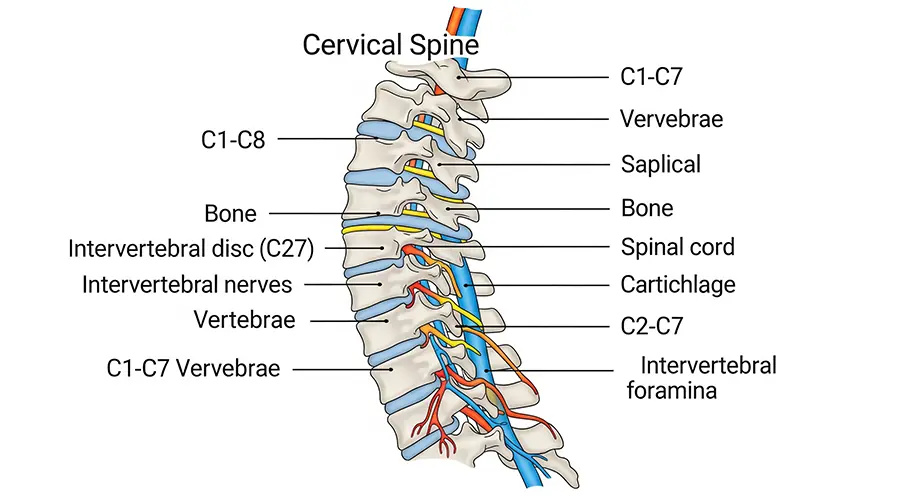
Introduction: Understanding Neck Pain
The neck, or the cervical spine, is a complex structure composed of vertebrae, intervertebral discs, joints, muscles, ligaments, and nerves, responsible for supporting the head and providing it with a wide range of motion. Due to this complexity and high mobility, the neck is susceptible to injury.
The Importance of the Topic and Its Prevalence in Modern Societies:
Neck pain is considered one of the most common musculoskeletal and spinal disorders after low back pain. This problem is more common in women and middle-aged individuals, but with changing lifestyle patterns, young adults and even teenagers are increasingly affected. According to statistics, more than two-thirds of the world's population will experience this issue at least once in their lifetime. Factors such as poor posture while working or using electronic devices, stress, and reduced physical activity play a significant role in its increased prevalence.
Highlighting Diverse Causes and the Necessity for Accurate Diagnosis:
Neck pain or Cervicalgia is caused by various reasons, ranging from simple muscle strains to more serious problems like a herniated disc or arthropathy. For this reason, an accurate diagnosis of the underlying cause of the pain is crucial for selecting the appropriate treatment method. Ignoring the pain or improper self-treatment can lead to chronic pain and further complications.
Common Causes of Neck Pain
Understanding the causes of neck pain is the first step towards effective treatment and prevention. Below, we discuss some of the most important reasons for this condition:
Poor Posture: This is one of the most common causes of neck pain, especially in today's world. Prolonged bending of the head forward while working with a computer, reading, or using a mobile phone puts significant pressure on the vertebrae and muscles of the neck. Additionally, sleeping in an awkward position or using an unsuitable pillow can cause morning neck pain.

Muscle Strain and Tension: Emotional and physical stress are strongly linked to neck pain in individuals. Moderate to severe stress increases the cortisol level in the bloodstream, which can increase pro-inflammatory mediators. This prolonged contraction can cause fatigue, stiffness, and pain in these areas. Teeth grinding (Bruxism) during sleep can also put considerable strain on the neck muscles.
Cervical Herniated Disc: The intervertebral discs act like cushions that absorb shocks to the spine. With age or due to injury, the gelatinous inner part of the disc may protrude (herniate) through its outer wall and press on adjacent nerves. This condition can lead to severe neck pain, pain radiating to the arm, numbness, or muscle weakness.

Cervical Discopathy and Spinal Stenosis: A moderate to severe disc bulge or protrusion can narrow the central spinal canal, leading to spinal cord compression. This will disrupt the electrical signal to the radicular nerves and cause compression. This narrowing can be caused by arthritis, the growth of bone spurs, or thickening of ligaments. Symptoms include neck pain, numbness, tingling, and weakness in the arms and legs, and in severe cases, difficulty walking and loss of bladder or bowel control.
Cervical Spondylosis (Neck Arthritis): This condition is more common in older adults and can cause stiffness, pain, and limited range of motion in the neck. The body may respond to this wear and tear by forming bone spurs (osteophytes), which can put pressure on nerves or the spinal cord.
Pinched Nerve (Cervical Radiculopathy): When a nerve root in the neck area is compressed due to a herniated disc, bone spurs, or spinal stenosis, symptoms such as sharp, shooting pain that radiates to the shoulder, arm, or hands, numbness, tingling, or muscle weakness along that same path may occur.
Injuries: Sudden trauma such as "whiplash" injuries, often occurring in car accidents, falls, or sports injuries, can cause strains or tears in the neck muscles and ligaments, damage to discs, or even vertebral fractures, leading to severe pain.
Less Common Causes of Neck Pain:
- Tumors: Although rare, benign or malignant tumors in the cervical spine area or surrounding tissues can cause pain.
- Infections: Infections such as meningitis (infection of the membranes surrounding the brain and spinal cord) or osteomyelitis (infection of the vertebral bone) can cause severe neck pain accompanied by fever and other systemic symptoms.
- Rheumatic Diseases: Diseases like rheumatoid arthritis or ankylosing spondylitis can affect the neck joints, causing inflammation and pain.
- Subarachnoid Hemorrhage: This is an emergency condition caused by bleeding in the space surrounding the brain (often due to a ruptured aneurysm), and one of its characteristic symptoms is a very severe and sudden headache accompanied by neck stiffness.
- Concussion (Traumatic Brain Injury): Sometimes, a blow to the head can be associated with neck pain and stiffness.
Symptoms Associated with Neck Pain
The symptoms of neck pain can vary depending on its cause and severity. Some of the most common symptoms include:
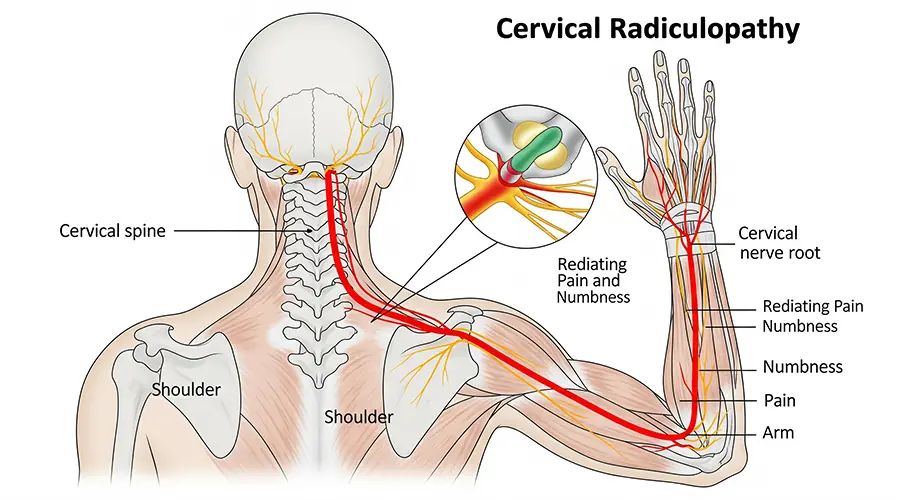
- Localized pain in the neck area: This pain can be sharp, dull, burning, or throbbing and is often aggravated by moving the neck. Sometimes the pain may be limited to one side of the neck (left-sided neck pain or right-sided neck pain).
- Headache: Neck pain is often accompanied by headaches, especially in the occipital region (back of the head), which is called a "cervicogenic headache." These headaches are usually caused by muscle tension, trigger points, or irritation of the upper neck nerves.
- Limited neck movement and stiffness: It may be difficult and painful to turn the head to the sides, bend it forwards and backwards, or tilt the neck. Morning stiffness, where individuals have a moderately to severely limited active range of motion in the cervical spine, is a result of this complication.
- Numbness or tingling in the hands (Paresthesia): If the pressure on the nerves is severe, sensations of numbness, pins and needles (tingling), or weakness in the arms, hands, or fingers may occur. These symptoms indicate nerve involvement (radiculopathy).
- Weakness in the arms or legs: In more severe cases, such as significant spinal stenosis or a large herniated disc compressing the spinal cord (myelopathy), weakness in the hands (e.g., difficulty gripping objects) or legs, and impaired balance and walking may also be observed.
- Dizziness or lightheadedness: Occasionally, dizziness may also occur, especially if the blood vessels in the neck are affected or if an inner ear problem is exacerbated by neck tension.
Diagnosing the Cause of Neck Pain
An accurate diagnosis of the cause of neck pain is essential for effective treatment planning. A doctor typically uses the following methods for diagnosis:
Clinical Interview and History Taking: The doctor will ask detailed questions about the onset of pain, its type, intensity, factors that alleviate or worsen it, medical history, occupation, daily habits, and potential injuries.
Physical Examination:
- Observation: Examining the posture of the head and neck, and checking for any swelling or deformities.
- Palpation: Touching different areas of your neck, shoulders, and upper back to find tender spots, muscle spasms (trigger points), and to check lymph nodes.
- Range of Motion Assessment: Assessing the active and passive range of motion of your neck and identifying any pain or limitations.
- Neurological Examinations: Assessing muscle strength, nerve reflexes, and sensation to check for signs of pressure on nerves or the spinal cord.
Imaging:
- X-ray: Can show bone problems like arthritis, bone spurs, reduced disc space, fractures, or instability.
- MRI (Magnetic Resonance Imaging): Provides detailed images of soft tissues, including discs, the spinal cord, nerve roots, and muscles. Very useful for diagnosing herniated discs and spinal stenosis.
- CT Scan (Computed Tomography): Provides more detailed views of bones than X-rays.
Electromyography (EMG) and Nerve Conduction Studies (NCS): Evaluate the electrical activity of nerves and muscles, usually ordered for neurological symptoms.
Blood Tests: May be ordered to check for inflammatory markers if infection or systemic inflammatory diseases are suspected.
Lumbar Puncture (Spinal Tap): Rarely performed unless there is suspicion of a central nervous system infection like meningitis.
The doctor arrives at a final diagnosis based on the collective information from the patient's history, physical examination, and, if necessary, the results of tests and imaging.
Treatment Methods for Neck Pain
Effective, Non-Surgical Treatment for Your Neck Pain
Two of the most effective conservative treatments to resolve neck pain are Physiotherapy and Chiropractic care. These therapies target the root cause of your pain to provide lasting relief without medication or surgery.
Learn more about how our expert team can help you.
The appropriate treatment method depends on the underlying cause, severity of pain, and the patient's overall condition. Chiropractic spinal mobilizations, adjustments, and manual therapy are considered very beneficial. Physiotherapy is also a safe and effective way to treat cervicalgia conservatively.
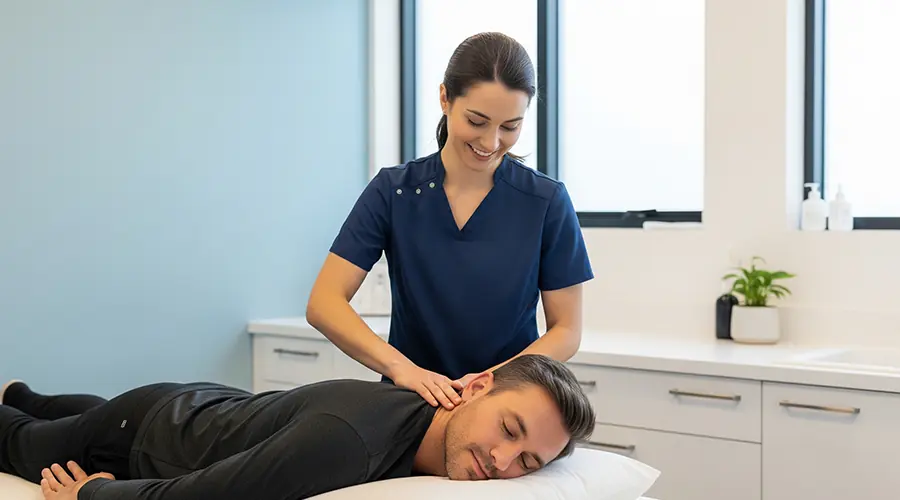
Home Remedies and Self-care
- Rest: Brief rest for a day or two can be beneficial, but prolonged rest is not recommended.
- Cold Therapy: Applying an ice pack for 15-20 minutes at a time within the first 48 hours can help reduce inflammation and swelling.
- Heat Therapy: After 48 hours, or for chronic pain, using a heating pad can help relax muscles and increase blood flow.
- Gentle Stretching Exercises: After the initial pain subsides, gentle neck stretches can help maintain flexibility.
MEDICAL INTERVENTIONS:
Over-the-Counter (OTC) Pain Relievers:
- Nonsteroidal anti-inflammatory drugs (NSAIDs) such as ibuprofen or naproxen can help reduce both pain and inflammation. Acetaminophen (Paracetamol) is effective for pain relief but does not have significant anti-inflammatory effects. Long-term use of these drugs should be monitored by a doctor.
Topical Creams and Ointments: Creams containing menthol, camphor, or capsaicin can provide local pain relief.
Muscle Relaxants: May be prescribed for a short period for severe muscle spasms.
Antidepressants and Anticonvulsants: Certain medications like amitriptyline or gabapentin can be effective for chronic neuropathic pain.
Oral Corticosteroids: A short course may be prescribed for severe inflammation.
Injections:
- Cervical Epidural Steroid Injection: Injects a strong corticosteroid near the spinal cord to reduce inflammation from a herniated disc or spinal stenosis.
- Trigger Point Injection: Injects a local anesthetic or steroid into painful muscle knots.
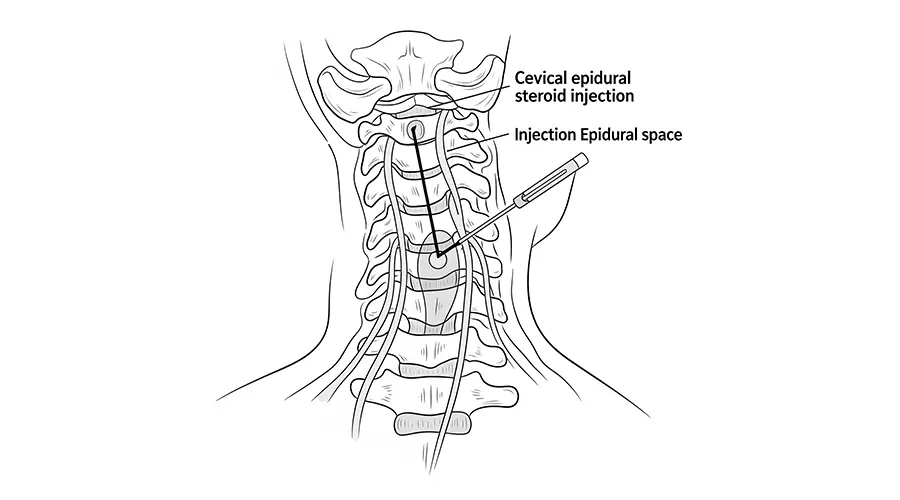
A physiotherapist or Chiropractor can design a tailored program including:
- Posture Correction Education
- Stretching and Strengthening Exercises
- Manual Therapy Techniques
- Use of Modalities: Such as ultrasound, TENS, or laser therapy.
Other Therapies:
- Massage Therapy: Can help relax contracted muscles and reduce stress.
- Dry Needling or Acupuncture: Research is ongoing, but it appears to be beneficial for some individuals.
- Chiropractic Care: Uses spinal adjustments to improve joint alignment and function.
- Use of a Cervical Collar: May be recommended for a short period after an acute injury, but prolonged use is discouraged.
- Dry Cupping Therapy: This traditional method can also help improve blood flow and relieve muscle tension.
Surgery: Surgery is a last resort, considered only when conservative treatments fail and there are severe or progressive symptoms, such as:
- Severe herniated disc with significant nerve or spinal cord compression.
- Severe spinal stenosis causing myelopathy.
- Fracture or dislocation of cervical vertebrae.
- Instability of the cervical spine.
- Tumors.
Preventing Neck Pain: Steps for a Healthy Neck
Prevention is always better than cure. Following these tips can significantly reduce your risk:
Maintain Good Posture:
- When sitting: Sit up straight, shoulders back, with ears aligned over your shoulders.
- When working with a computer: Position the monitor at eye level.
- When using a mobile phone: Bring the device up to eye level instead of bending your head down.
Take Regular Breaks: Every 30-60 minutes, stand up, walk, and perform gentle neck stretches.
Simple Stretching Exercises:
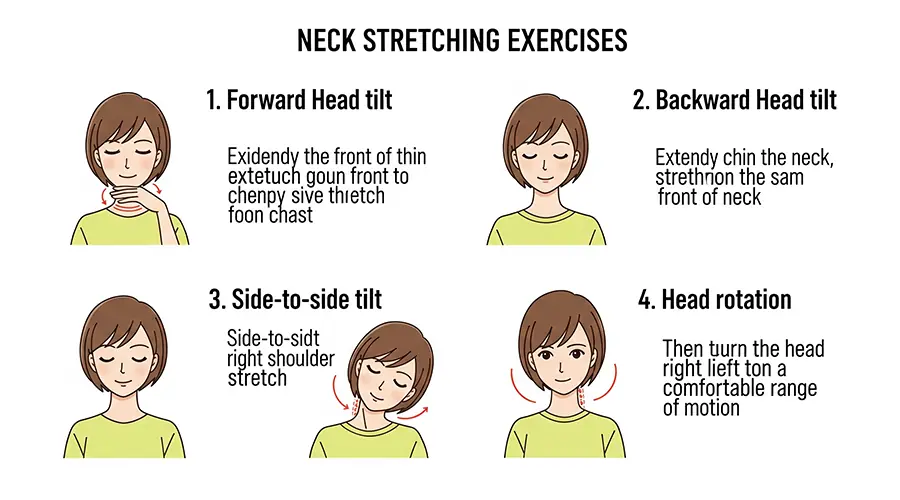
- Gently tilt your head forward, backward, and side to side.
- Slowly rotate your head.
- Shrug your shoulders up and down.
Use a Suitable Pillow While Sleeping: Choose a pillow that keeps your head and neck aligned with your spine. Avoid sleeping on your stomach.
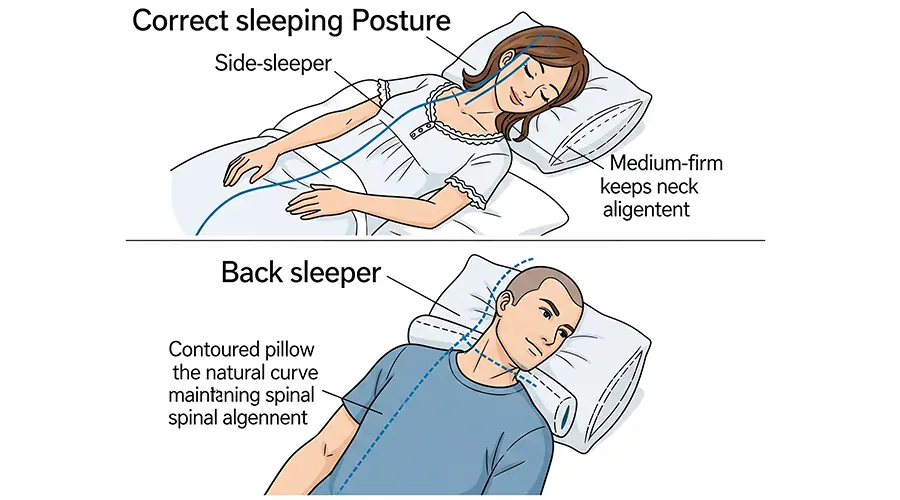
Strengthen Neck and Back Muscles: Regular exercise helps improve stability.
Avoid Carrying Heavy Loads on One Shoulder: Use a backpack and distribute weight evenly.
Engage in Regular Exercise: General physical activity improves overall muscle health and flexibility.
When Should You See a Doctor?
While many cases improve with home care, consult a doctor if you experience any of the following warning signs:
- Severe and persistent pain that doesn't improve after a few weeks.
- Pain that radiates into your arm or leg.
- Weakness, numbness, or a tingling sensation in your arms, hands, or legs.
- Neck pain that develops after an injury or trauma (car accident, fall).
- Pain accompanied by fever or chills.
- Unexplained weight loss.
- A severe, sudden headache with neck stiffness (a medical emergency).
- Difficulty with balance or walking.
- Bowel or bladder dysfunction (a serious red flag requiring immediate attention).
- Swelling or a lump in the neck area.
- New neck pain with a history of cancer or rheumatic diseases.
Final Conclusion: The Importance of Accurate Diagnosis and the Role of Lifestyle
Neck pain is a common problem with a wide variety of causes. An accurate diagnosis by a doctor is the key to choosing an effective treatment. Self-treatment or ignoring symptoms, especially warning signs, can lead to chronic pain and more serious complications.
Fortunately, many cases of neck pain improve with conservative treatments and lifestyle modifications. By paying attention to your posture, performing regular exercises, and managing stress, you can largely prevent this problem. Remember that the health of your neck is an important part of your overall well-being. If you have any concerns about your neck pain, be sure to consult with a specialist.



